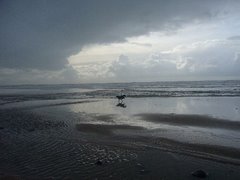
This is a Lakota Sioux Legend.
When the world was created, First Man and First Woman struggled to stay alive and warm through the first winter. First Dog struggled also. Deep in the winter, First Dog gave birth to her pups. Each night, she huddled in the brush of the forest, longingly watching the fire, which kept First Man and First Woman warm.
First Winter was severe, so cold that First Dog dared not leave her pups to search for food to fill her own belly, fearing that her pups would freeze to death in her absence. She curled around them, but the wind was bitter.
Her belly shrank with hunger, and soon she had no milk. The smallest pup perished, and First Dog felt her own life draining away as she struggled to care for the remaining pups. Fearing for the fate of the others, she knew she had no choice but to approach the fire and ask First Woman and First Man to share their food and the fire's warmth.
Slowly, she crept to the fire and spoke to First Woman, who was heavy with child. I am a mother, said First Dog, and soon you will be a mother too. I want my little ones to survive, just as you will want your little one to survive. So I will ask you to make a pact.
First Woman and First Man listened. I am about to die. Take my pups. You will raise them and call them Dog. They will be your guardians. They will alert you to danger, keep you warm, guard your camp, and even lay down their life to protect your life and the lives of your children.
They will be companions to you and all your generations, never leaving your side, as long as Mankind shall survive. In return, you will share your food and the warmth of your fire. You will treat my children with love and kindness, and tend to them if they become ill, just as if they were born from your own belly. And if they are in pain, you will take a sharp knife to their throat, and end their misery. In exchange for this, you will have the loyalty of my children and all their offspring until the end of time.
First Man and First Woman agreed. First Dog went to her nest in the brush, and with the last of her strength, one by one, she brought her pups to the fire. As she did so, First Woman gave birth to First Child, wrapped her in Rabbit skins, and nestled First Child among the pups by the fireside. First Dog lay down by the fire, licked her pups, then walked away to die under the stars.
Before she disappeared into the darkness, she turned and spoke once more to First Man. "My children will honor this pact for all generations. But if Man breaks this pact, if you or your children's children deny even one dog food, warmth, a kind word or a merciful end, your generations will be plagued with war, hunger and disease, and so this shall remain until the pact is honored again by all Mankind." With this, First Dog entered the night, and returned in spirit to the creator.
First Winter was severe, so cold that First Dog dared not leave her pups to search for food to fill her own belly, fearing that her pups would freeze to death in her absence. She curled around them, but the wind was bitter.
Her belly shrank with hunger, and soon she had no milk. The smallest pup perished, and First Dog felt her own life draining away as she struggled to care for the remaining pups. Fearing for the fate of the others, she knew she had no choice but to approach the fire and ask First Woman and First Man to share their food and the fire's warmth.
Slowly, she crept to the fire and spoke to First Woman, who was heavy with child. I am a mother, said First Dog, and soon you will be a mother too. I want my little ones to survive, just as you will want your little one to survive. So I will ask you to make a pact.
First Woman and First Man listened. I am about to die. Take my pups. You will raise them and call them Dog. They will be your guardians. They will alert you to danger, keep you warm, guard your camp, and even lay down their life to protect your life and the lives of your children.
They will be companions to you and all your generations, never leaving your side, as long as Mankind shall survive. In return, you will share your food and the warmth of your fire. You will treat my children with love and kindness, and tend to them if they become ill, just as if they were born from your own belly. And if they are in pain, you will take a sharp knife to their throat, and end their misery. In exchange for this, you will have the loyalty of my children and all their offspring until the end of time.
First Man and First Woman agreed. First Dog went to her nest in the brush, and with the last of her strength, one by one, she brought her pups to the fire. As she did so, First Woman gave birth to First Child, wrapped her in Rabbit skins, and nestled First Child among the pups by the fireside. First Dog lay down by the fire, licked her pups, then walked away to die under the stars.
Before she disappeared into the darkness, she turned and spoke once more to First Man. "My children will honor this pact for all generations. But if Man breaks this pact, if you or your children's children deny even one dog food, warmth, a kind word or a merciful end, your generations will be plagued with war, hunger and disease, and so this shall remain until the pact is honored again by all Mankind." With this, First Dog entered the night, and returned in spirit to the creator.














